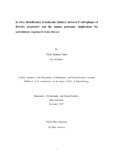In silico identification of molecular mimicry between T-cell epitopes of borrelia burgdorferi and the human proteome: implications for autoimmune response in Lyme disease

View/Open
Date
2022-12Publisher
Brac UniversityAuthor
Tanim, Tahsin MahmudMetadata
Show full item recordAbstract
Autoimmune disorder is a dysfunctional immune system in a body, which attacks its own cells. Borrelia burgdorferi, a pathogenic bacterium, shares an intrinsic relation to Lyme disease in humans causing autoreactive responses that remained a serious health concern for the public. Molecular mimicry is one of the primary mechanisms by which pathogen or toxic chemicals induce autoimmunity. In this research, a pipeline of bioinformatics tools was applied for examining the molecular mimicry between human and B. burgdorferi protein sequences from a structural perspective. In addition, the potential antigenic peptides of this
bacteria similar to the peptides of human were classified and the fundamental molecular
mechanisms of autoimmune disorders were analyzed. To initiate the study, proteome databases were retrieved and removed their paralogous sequences. Subsequently, the homologous proteins were identified along with enrichment pathways. Then, the subcellular localization of proteins were predicted followed by the prediction of MHC class II epitopes. Additionally, the 3D structure of the epitopes was modelled for comparing the structure of host and pathogen. The bacterial epitopes DFTIEVERSLRVLDG, LRLKKLIIDIMSNQI and
VIAQLLFLESEDSSK that superimposed with the respective host epitopes
DFTIEVERALRVLDG, MKLKKQLYNIYAKHT and VIAQLLFLQSESNKK showed 100%
binding which were highly predicted cross reactivity. Finally, docking scores of these bacterial epitopes revealed the binding affinity towards the host HLA alleles including DRB1*07:01, DRB1*01:01and DRB4*01:01 that may lead to autoimmune disorders in humans caused by B. burgdorferi infection.
